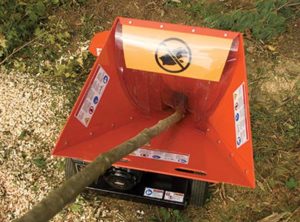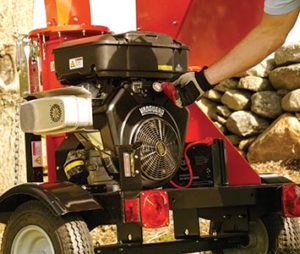
1. Wear safety gear.

Wear eye protection and ear protection when chipping. These machines are loud and often fling tiny pieces of debris into the air. Avoid catching one in the eye by keeping your DR Safety Gear on at all times. Also, as with all power equipment, be sure to wear closed-toe shoes. Steel-enforced boots are recommended if you are chipping particularly large and heavy branches. Be sure that loose pieces of clothing are tucked in and not at risk of getting stuck in the chipper.
2. Be careful what you chip.
Wood chippers are designed to chip branches and tree limbs. They are not designed to chip metal, plastic, processed wood (such as 2-by-4s), or leftover building materials. Be sure that you only chip branches that are in the size range that your chipper is designed to chip. For example, if your chipper is designed to chip up to 4″ diameter branches, trying to feed a 5″ diameter branch into the hopper can clog the machine, put unnecessary stress on the engine, and put you in danger.
3. Don’t put your hands in the hopper!



If you have a clog in the discharge chute or chipping chamber, or if you need to do routine maintenance, be sure to turn off your engine before you do anything. After turning the engine off, wait until the flywheel has completely stopped spinning. The heavier the flywheel, the longer it will take to come to a complete stop. But while it is still spinning, there is still the danger of injury, so it is well worth the wait.
5. Keep kids and pets at a safe distance from the wood chipper.
Keep kids, pets, and other bystanders a safe distance away from the wood chipper while you’re working. Flying debris, loose wood chips on the ground, heavy branches, and the dangerous nature of the machine itself make it a very unsafe place for children and pets.
